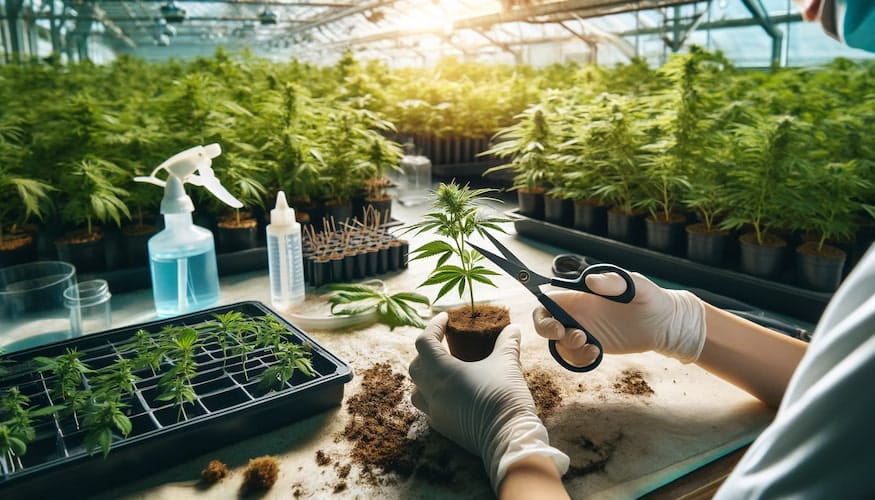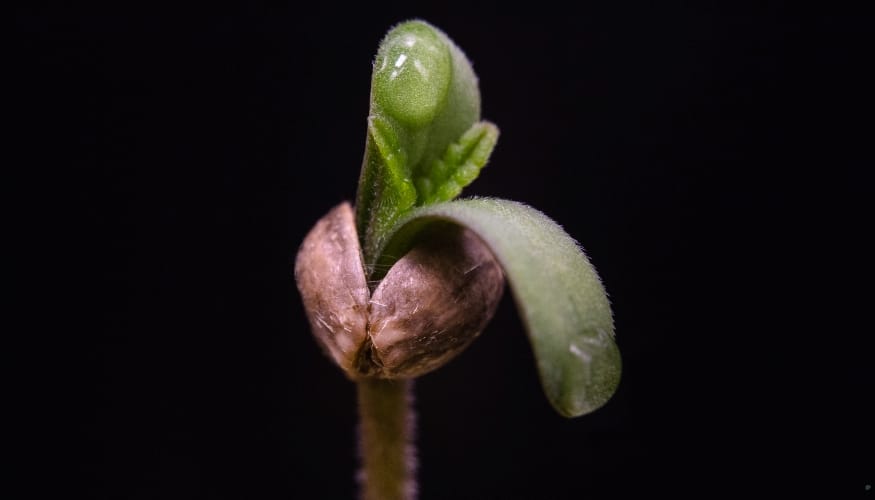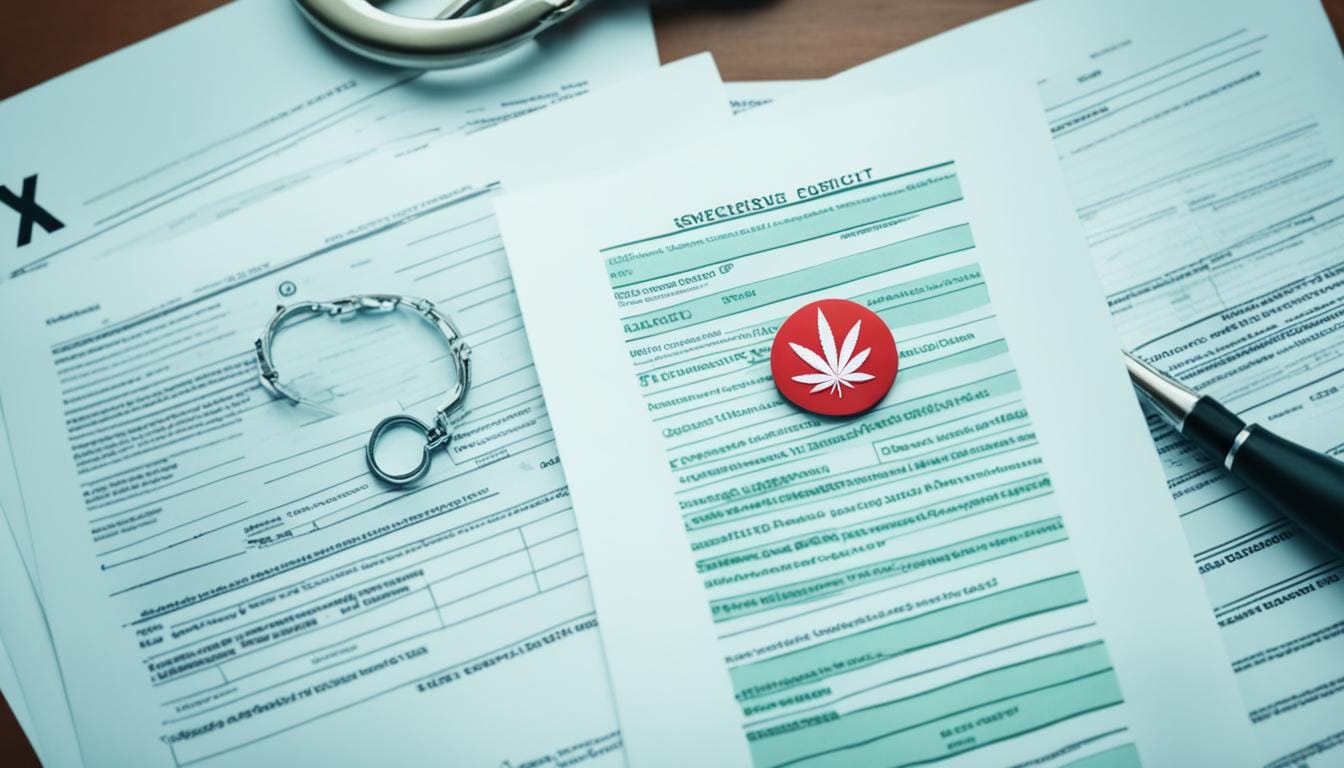Discover the cost-savings and yields boost with feminized seeds. Perfect for growers seeking efficiency in their personal or commercial operations.
Germinating Seeds in Rockwool: A Complete Guide
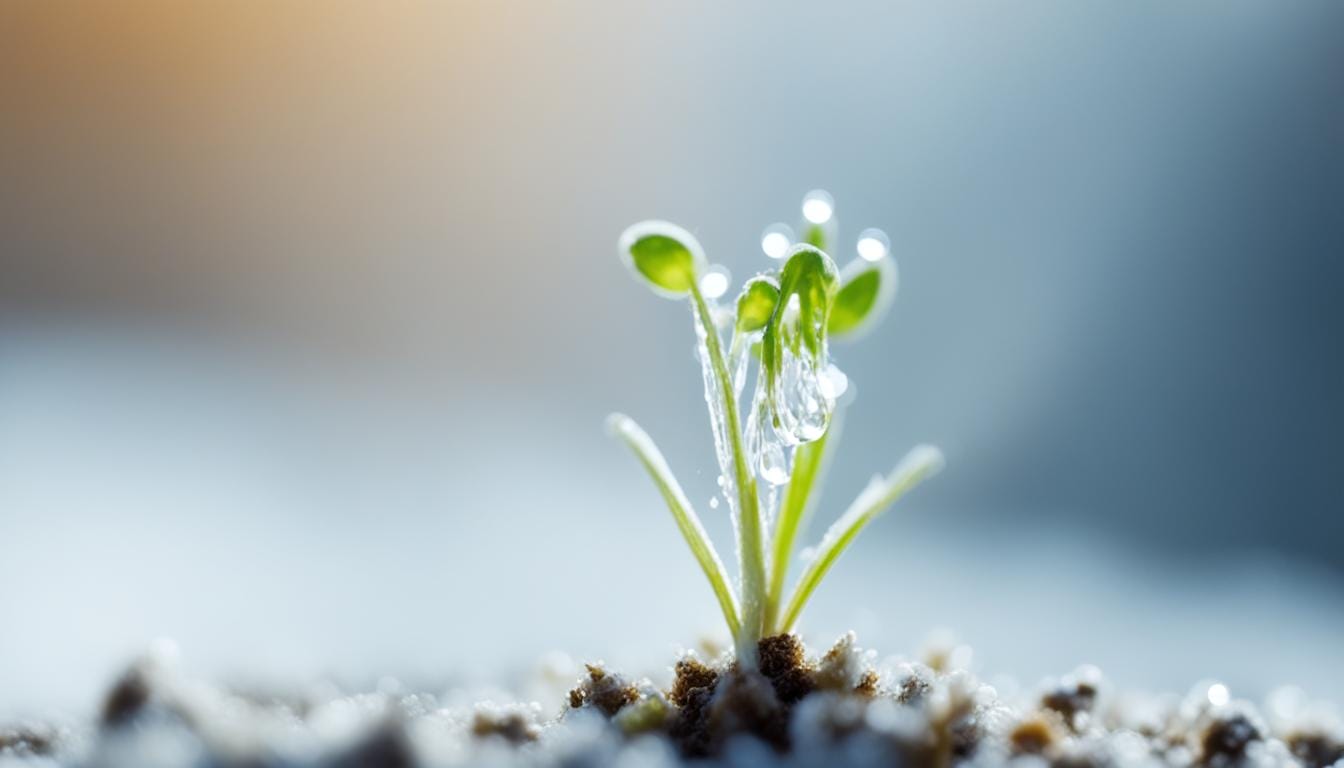
Have you ever wondered how to germinate seeds in Rockwool, a popular growing medium known for its efficiency and effectiveness? Well, look no further! In this step-by-step guide, we will unravel the secrets to successfully germinating seeds in Rockwool, providing you with all the knowledge and tips you need to achieve healthy plant starts effortlessly.
Many gardeners and horticulture enthusiasts rely on Rockwool for its exceptional water retention, aeration, and insulation properties. But how exactly do you harness the power of this unique growing medium to kickstart your seeds’ growth? Join us as we delve into the art of Rockwool seed germination and unlock the potential of this remarkable cultivation technique.
Key Takeaways:
- Germinating seeds in Rockwool offers a reliable and efficient method for starting plants.
- Rockwool is a growing medium known for its exceptional water retention and aeration properties.
- Choosing the right Rockwool product is crucial for successful seed germination.
- Properly preparing the Rockwool cubes and seeds is essential for optimal germination.
- Maintaining ideal conditions, such as temperature and humidity, is crucial for the germination process.
Understanding Rockwool as a Growing Medium
Before we discuss the germination process, let’s examine Rockwool as a growing medium. Rockwool, also known as stone wool or mineral wool, is a popular choice among gardeners for starting seeds. It is made from molten rock spun into fibers, creating a porous and sterile material that provides an ideal environment for seed germination and early plant development.
Rockwool offers several advantages as a growing medium. Firstly, its excellent water-holding capacity allows for efficient moisture retention, ensuring that seeds receive adequate hydration during the germination process. This is essential for healthy root development and overall plant growth.
Furthermore, Rockwool’s structure provides optimal air circulation, preventing waterlogged conditions and ensuring proper oxygen availability to the developing roots. The fibers also provide insulation, helping to maintain a stable temperature, which is crucial for successful germination.
Another advantage of using Rockwool is its sterile nature. This eliminates the risk of soil-borne diseases and pests that can inhibit seed germination and damage seedlings. With Rockwool, you can start your seeds in a clean and controlled environment, giving them the best possible chance of thriving.
Key benefits of using Rockwool as a growing medium:
- Efficient water retention
- Proper air circulation
- Insulation for temperature stability
- Sterile environment
With these characteristics, Rockwool provides an ideal foundation for germinating seeds and nurturing healthy seedlings. In the next section, we will guide you through the process of choosing the right Rockwool for seed germination, so stay tuned!
Choosing the Right Rockwool for Germination
Not all Rockwool products are created equal when it comes to germinating seeds. Choosing the best Rockwool for your specific needs is crucial to ensuring optimal conditions for successful germination. Here are some factors to consider when selecting the perfect Rockwool for your seed-starting journey.
1. R-Value and Water-Holding Capacity
One key factor to consider is the R-value and water-holding capacity of the Rockwool. R-value refers to the thermal resistance, which directly affects the insulation properties of the Rockwool. Opt for Rockwool with a higher R-value, as it provides better temperature regulation for your seeds.
The water-holding capacity is equally important as it determines the ability of the Rockwool to retain moisture. Look for Rockwool that has good water retention properties, ensuring that your seeds receive consistent hydration throughout the germination process.
2. pH Neutral
It is essential to choose a Rockwool product that has a neutral pH, as seeds require a neutral pH environment for healthy germination. By using pH-neutral Rockwool, you can avoid any fluctuations in pH levels that may inhibit seed growth and development.
3. Density and Root Penetration
The density of Rockwool influences the ease of root penetration. It is recommended to choose Rockwool with a lower density, as it allows roots to grow more freely and establish a strong foundation for future plant growth.
4. Avoiding Chemical Additives
When selecting Rockwool for germination, be sure to choose products that are free from chemical additives or treatments. These additives can potentially harm your seeds or affect their germination process. Opting for natural and untreated Rockwool ensures a safe and conducive environment for seed starting.
Remember, choosing the right Rockwool is a critical step in ensuring the success of your seed germination process. Take the time to research and select a high-quality product that meets all the necessary requirements to provide your seeds with the best possible start.
To help you understand the factors to consider when choosing Rockwool for seed germination, refer to the table below:
| Rockwool Characteristics | Importance |
|---|---|
| R-value and Water Holding Capacity | Ensures temperature regulation and consistent moisture levels |
| pH Neutral | Provides a conducive environment for seed germination |
| Density and Root Penetration | Affects root growth and establishment |
| Avoiding Chemical Additives | Promotes a safe and healthy germination process |
With the proper selection of Rockwool, you can create an ideal environment for your seeds to thrive. So be mindful of these factors when choosing the best Rockwool for your seed germination needs, and set yourself up for a successful gardening journey.
Preparing Rockwool for Seed Germination
Properly preparing Rockwool before germination is crucial for maximizing the success rate of seed starting. By following these Rockwool germination tips, you can provide an optimal environment for your seeds to thrive.
1. Soaking Rockwool Cubes
Before planting your seeds, it’s essential to soak the Rockwool cubes in water. This helps to ensure that the cubes are fully saturated and ready to provide the necessary moisture for seed germination. Place the cubes in a tray or container filled with water, allowing them to absorb water for approximately 10 to 15 minutes. Once the cubes are thoroughly soaked, remove them from the water and let excess moisture drain away.
2. Adjusting pH Levels
Rockwool typically has a high pH level, which may not be ideal for seed germination. To adjust the pH and create a more favorable environment, you can soak the Rockwool cubes in a solution of water and a pH-adjusting substance like lemon juice or vinegar. Aim for a pH level of around 5.5 to 6.5, which is slightly acidic and suitable for most seeds.
3. Creating Drainage Holes
Ensuring proper drainage is essential for preventing waterlogged Rockwool and potential seedling rot. Before planting your seeds, use a sterile tool to create small drainage holes at the bottom of each Rockwool cube. These holes allow excess water to escape, maintaining a healthy moisture balance within the cubes.
4. Treating with Seed Starter Solution
Consider treating the Rockwool cubes with a seed starter solution to provide additional nutrients and promote seedling growth. Seed starter solutions are commercially available and often contain essential elements like nitrogen, phosphorus, and potassium, along with vitamins and hormones specifically designed to support seed development. Follow the instructions provided on the product label for the correct dosage and application method.
To summarize, by following these Rockwool germination tips, you can ensure that your Rockwool cubes are primed for successful seed germination. Soak the cubes, adjust the pH levels, create drainage holes, and consider treating them with a seed starter solution. With these preparations in place, you’ll be well on your way to growing healthy and vibrant seedlings.
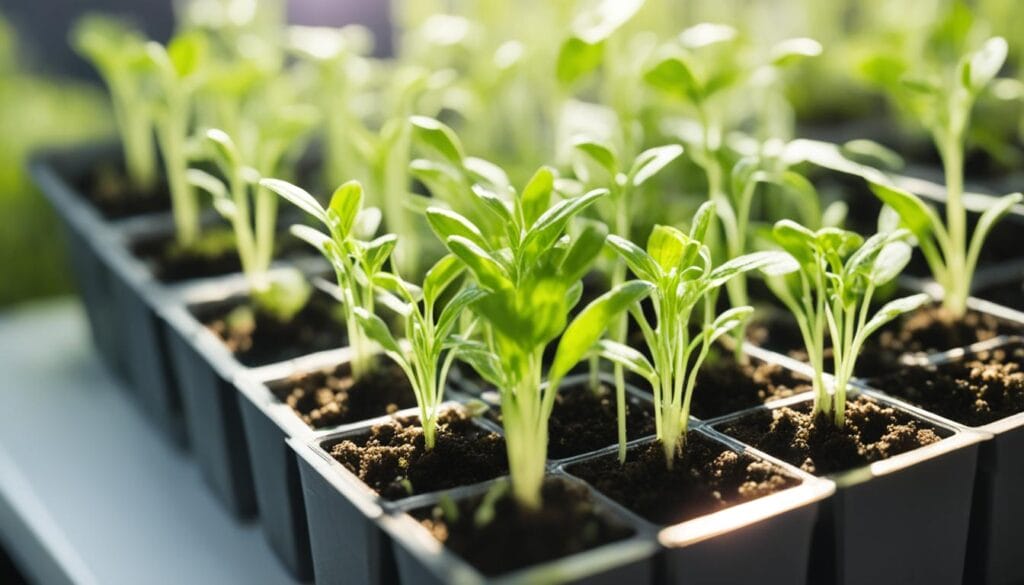
Selecting and Prepping Seeds for Germination
Before you start germinating seeds in Rockwool, it’s crucial to choose the right seeds and prepare them for successful germination. By following these essential steps, you’ll ensure that your seeds have the best chance of thriving in the Rockwool growing medium.
Choosing the Best Seeds for Rockwool Germination
When selecting seeds for Rockwool germination, opt for reputable seed companies and choose seeds that are known to perform well in hydroponic or soilless systems. Look for varieties that have a high germination rate and are suitable for the specific type of plant you wish to grow.
Consider these factors when choosing seeds for Rockwool germination:
- Germination rate: Select seeds with a high germination rate to increase the chances of successful seedlings.
- Plant type: Different plants have different germination requirements. Choose seeds that are compatible with Rockwool and suitable for your intended growing system.
- Quality: Choose seeds from trusted sources to ensure they are viable and free from disease or genetic abnormalities.
Prepping Seeds for Germination
Properly preparing seeds before germination can enhance their viability and promote optimal growth. Here’s how you can prep your seeds:
- Clean and disinfect: First, clean the seeds to remove debris or contaminants. Then, gently rinse them in clean water or use a seed disinfectant solution to reduce the risk of pathogens.
- Scarification: Some seeds, especially those with hard coats, benefit from scarification, which helps break the seed coat and speeds up germination. You can achieve this by gently rubbing the seeds with sandpaper or using a specialized seed scarification tool.
- Soaking: Soaking seeds before planting can improve germination rates, especially for larger seeds. Place the seeds in a container with clean water and let them soak for the recommended time specified on the seed packet.
- Stratification: Certain seeds, particularly those native to colder climates, require stratification or a period of cold temperature exposure to break dormancy. Follow the instructions on the seed packet for the specific duration and temperature requirements.
Remember, different plant species may have unique requirements for scarification, soaking, or stratification. Always refer to the seed packet or consult reliable gardening resources for specific instructions.
Now that you know how to select and prepare your seeds, it’s time to move on to the next step: planting seeds in Rockwool cubes. This crucial step will bring you one step closer to successful germination and healthy plant starts.
Planting Seeds in Rockwool Cubes
Now that everything is prepared, it’s time to plant the seeds in the Rockwool cubes. Follow these steps to ensure proper placement and handling of the seeds for optimal germination:
- Prepare the Rockwool cubes: Before planting the seeds, make sure the Rockwool cubes are adequately moistened. This will create a favorable environment for seed germination.
- Make small holes: Use a pen or pencil to create small holes in the Rockwool cubes. The holes should be deep enough to accommodate the size of the seeds.
- Place the seeds: Gently place one seed in each hole. Be careful not to damage the delicate roots or seedlings if they have already sprouted.
- Cover the seeds: Once the seeds are in place, lightly cover them with a layer of Rockwool or vermiculite. This will protect the seeds and provide additional insulation.
- Label the cubes: To keep track of the different types of seeds you planted, use plant labels or small markers to indicate their names.
- Provide ideal conditions: After planting the seeds, ensure that they are kept in a warm and humid environment with proper lighting. Monitor the moisture levels regularly to prevent the Rockwool cubes from drying out.
Remember, each seed has its own requirements, so make sure to follow the specific instructions for each plant variety. By planting seeds properly in Rockwool cubes, you are setting the stage for successful germination and healthy plant growth.
“A garden requires patient labor and attention. Plants do not grow merely to satisfy ambitions or to fulfill good intentions. They thrive because someone expended effort on them.” – Liberty Hyde Bailey
Seed Depth and Spacing
| Seed Variety | Recommended Seed Depth (inches) | Suggested Planting Distance (inches) |
|---|---|---|
| Lettuce | 1/8 | 4-6 |
| Tomato | 1/4 | 18-24 |
| Basil | 1/4 | 8-12 |
Providing Ideal Conditions for Germination
Creating the right environment is crucial for successful seed germination in Rockwool. By providing the ideal conditions, you can ensure that your seeds have the best chance of sprouting and growing into healthy plants. Here, we will discuss the key factors to consider: temperature, humidity, light, and hydroponic seed germination.
Achieving Optimal Temperature
The temperature plays a vital role in seed germination. Most plant species have a preferred range for optimum growth. For germinating seeds in Rockwool, maintaining a temperature range of 70 to 85 degrees Fahrenheit (21-29°C) is recommended. This temperature range provides an ideal balance, allowing the seeds to activate enzymes responsible for breaking dormancy and initiating growth.
Ensuring Adequate Humidity
Humidity is another important factor in seed germination. It is essential to maintain a humid environment to prevent the seeds from drying out and to facilitate water absorption. To achieve this, you can cover the Rockwool cubes with a clear dome or place them in a humidity dome. This will help create a microclimate with high humidity and promote successful germination.
Providing Sufficient Light
Light is crucial for the germination process, as it signals the seeds to emerge from dormancy and start photosynthesis. Place your Rockwool cubes in a well-lit area or under grow lights. Ensure the light intensity is appropriate for the plant species you are germinating. Different plants require different light requirements, so research the specific needs of your seeds for optimal growth.
Tips for Hydroponic Seed Germination
If you are using Rockwool in a hydroponic system for seed germination, there are a few additional considerations. Firstly, ensure that your hydroponic setup provides a constant flow of nutrient-rich water to the Rockwool cubes. This will deliver essential nutrients and support healthy root development. Secondly, monitor the pH level of the nutrient solution to maintain an optimal range for nutrient absorption. A pH range of 5.5 to 6.5 is generally suitable for most plants. Finally, remember to check and adjust the nutrient concentration regularly to meet the specific needs of your plants.
To summarize, providing the ideal conditions for germinating seeds in Rockwool is key to maximizing the success of your seed-starting efforts. By maintaining optimal temperature, humidity, and light levels, you can create an environment that promotes healthy seed germination. If using Rockwool in a hydroponic system, ensure proper nutrient delivery and pH control. With these factors in mind, you’ll be on your way to successful seed germination in Rockwool.
Watering and Maintaining Rockwool for Germination
Proper watering and maintenance are crucial for the successful germination of seeds in Rockwool. In this section, we will provide you with essential guidance on how to water and care for Rockwool during the germination process, ensuring optimal conditions for seedling growth.
Watering Rockwool for Germination
Watering is a critical aspect of Rockwool seed germination. It is important to maintain consistent moisture levels without overwatering. Follow these steps to properly water Rockwool for germination:
- Soak: Before planting the seeds, soak the Rockwool cubes in water for about 10-15 minutes to ensure thorough hydration.
- Drain: After soaking, allow excess water to drain from the cubes. Rockwool should be moist but not waterlogged.
- Mist: To maintain moisture, regularly mist the Rockwool cubes with a spray bottle. A fine mist helps prevent overwatering and promotes even moisture distribution.
- Monitor: Gently squeeze the Rockwool cubes to check their moisture level regularly. If they feel dry or slightly light, it’s time to mist them again.
Maintaining Rockwool for Germination
In addition to proper watering, maintaining the Rockwool during the germination process is essential for successful seedling development. Consider the following maintenance tips:
- Temperature: Keep the germination area at a consistent temperature of around 70-75°F (21-24°C) to provide optimal conditions for seedling growth.
- Humidity: To maintain a humid environment, cover the Rockwool cubes with a clear dome or plastic wrap. This helps retain moisture and creates a mini greenhouse effect.
- Light: Place the Rockwool cubes in a well-lit area for seed germination. If natural light is not sufficient, consider using a fluorescent grow light.
- Avoid Disturbance: Once the seeds are planted in Rockwool, do not move or disturb the cubes unnecessarily. This allows the roots to be established and prevents damage to the delicate seedlings.
Remember, proper watering and maintenance play a vital role in the success of Rockwool seed germination. By following these guidelines, you can provide the optimal conditions needed for healthy and vigorous seedling growth.
| Common Mistakes to Avoid | Best Practices for Maintenance |
|---|---|
| Overwatering Rockwool, leading to root rot | Properly drain excess water from Rockwool cubes |
| Underwatering Rockwool, causing seedling dehydration | Maintain consistent moisture by misting regularly |
| Inconsistent temperature or humidity levels | Monitor and adjust temperature and humidity as needed |
| Insufficient light for seedling growth | Ensure adequate light exposure or use artificial grow lights |
| Excessive handling or disturbance of Rockwool cubes | Minimize movement to promote root establishment |
Monitoring and Troubleshooting Germination Progress
Once you’ve planted your seeds in Rockwool and provided the ideal conditions for germination, it’s important to regularly monitor their progress. By closely observing your seeds’ development, you can identify any issues that may arise and take appropriate action to ensure successful germination.
Troubleshooting Tips
Here are some key steps to help you effectively monitor and troubleshoot the germination process:
- Keep a daily journal: Record the date of planting, daily progress, and any observations you make. This will help you track the seeds’ growth rate and identify any anomalies that may indicate potential problems.
- Observe seedling emergence: As the germination process begins, closely monitor the Rockwool cubes for signs of seedlings breaking through the surface. This indicates that the seeds are successfully sprouting. Take note of the time it takes for seedlings to emerge and compare it to the expected germination time for the specific plant species.
- Check for uniform growth: Assess the seedlings’ growth to ensure uniformity. Uneven growth may indicate inconsistent environmental conditions or issues with the Rockwool cubes, such as improper moisture levels or pH imbalance.
- Watch for discoloration or wilting: Keep an eye out for any discoloration, wilting, or stunted growth in the seedlings. These signs may suggest nutrient deficiencies, overwatering, or diseases. Promptly address these issues to prevent further damage.
- Adjust environmental parameters: If you notice slow or poor germination, adjust the temperature, humidity, or lighting conditions. Ensure that the seeds are receiving the optimal conditions required for successful germination.
If you encounter any difficulties during the germination process, it’s important not to get discouraged. With careful monitoring and timely troubleshooting, you can address issues effectively and increase the chances of successful seed germination in Rockwool.
Remember, every plant species has its unique germination requirements, so it’s essential to research specific guidelines for the seeds you are working with. Stay vigilant, take notes, and always be ready to adapt and provide the necessary support to your germinating seeds.
Troubleshooting Tips
| Issue | Possible Causes | Solutions |
|---|---|---|
| Poor germination rate | Inadequate moisture levels, incorrect temperature, low seed viability | Ensure proper moisture levels, maintain optimal temperature, use fresh and viable seeds |
| Uneven seedling growth | Inconsistent environmental conditions, improper Rockwool preparation | Ensure uniform environmental conditions, properly prepare Rockwool cubes |
| Discoloration or wilting | Nutrient deficiencies, overwatering, diseases | Provide proper nutrients, adjust watering frequency, address diseases if necessary |
By following these monitoring techniques and troubleshooting tips, you can stay proactive in ensuring the success of your Rockwool seed germination. Remember, the key to a healthy and flourishing garden starts from the very beginning – the germination stage!
Transferring Germinated Seeds to the Growing Medium
Once your seeds have successfully germinated in Rockwool, it’s time to transfer them to their new growing medium. This important step ensures that your seedlings continue to thrive and develop into healthy plants. Follow these step-by-step instructions to safely transition your germinated seeds:
- Carefully remove the germinated seedlings from the Rockwool cubes, taking care not to damage the delicate roots.
- Prepare your chosen growing medium, whether it’s soil, coco coir, or a hydroponic system.
- Create holes or depressions in the growing medium where you will plant each seedling.
- Gently place the germinated seedlings into the prepared holes, ensuring that the roots are fully covered with the growing medium.
- Lightly press the growing medium around each seedling to provide stability and proper contact between the roots and the medium.
- Carefully water the newly transplanted seedlings, ensuring that the growing medium is adequately moist but not oversaturated.
By following these steps, you can ensure a smooth transition for your germinated seeds from Rockwool to their new growing medium. Remember to monitor their progress closely and provide the appropriate care and attention as they continue to grow.
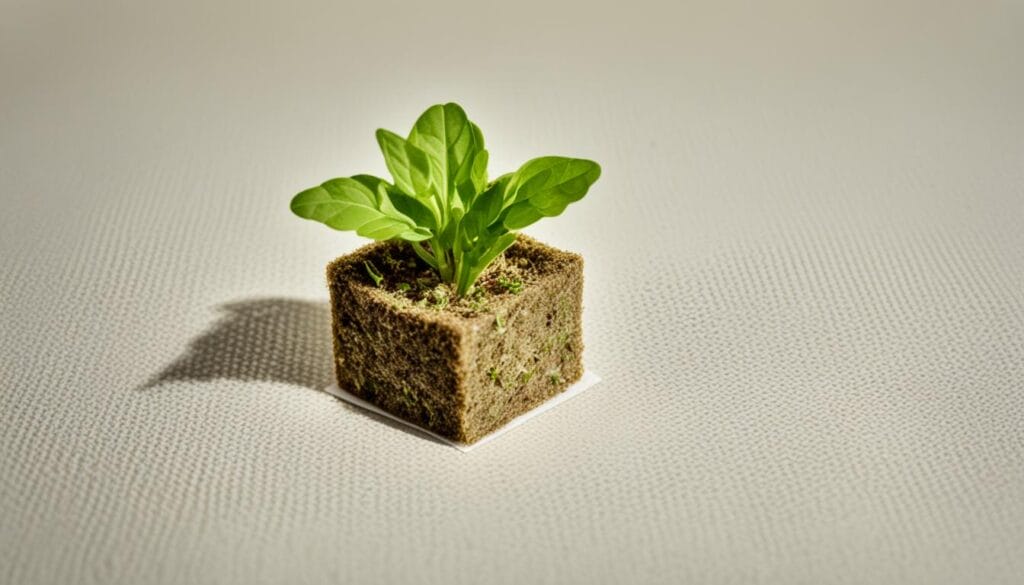
Conclusion
Germinating seeds in Rockwool is a tried and true method for successfully starting plants. By following the right techniques and providing proper care, you can ensure that your plant starts are healthy and robust, laying the foundation for a fruitful gardening journey.
Rockwool, as a growing medium, offers numerous benefits for seed germination. Its fibrous structure provides excellent aeration and moisture retention, creating an ideal environment for seedlings to develop strong roots. Additionally, Rockwool is lightweight and sterile, reducing the risk of pests and diseases.
Throughout this guide, we have covered everything from choosing the right Rockwool to planting the seeds and maintaining optimal conditions. You can greatly enhance the chances of successful germination by carefully selecting the best seeds, properly preparing the Rockwool cubes, and providing ideal temperature, humidity, and light conditions.
Remember to monitor the germination progress closely and address any issues that may arise promptly. With patience and attention to detail, you will witness the joy of seeing your seeds sprout and flourish into healthy plants. So, go ahead and embark on your Rockwool germination journey with confidence, knowing that you have the knowledge and tools to succeed.
Now that you know how to germinate seeds in Rockwool, get your garden started by shopping the collection of regular, feminized, and autoflower cannabis seeds at Seeds Here Now.
FAQ
What is Rockwool and why is it used as a growing medium for seed germination?
How do I choose the right Rockwool for germinating seeds?
How do I prepare Rockwool for seed germination?
What are the steps for planting seeds in Rockwool cubes?
What are the ideal conditions for germinating seeds in Rockwool?
How often should I water Rockwool during seed germination?
Why is it important to monitor the germination progress and troubleshoot issues?
How do I transfer germinated seeds from Rockwool to the final growing medium?
Back

